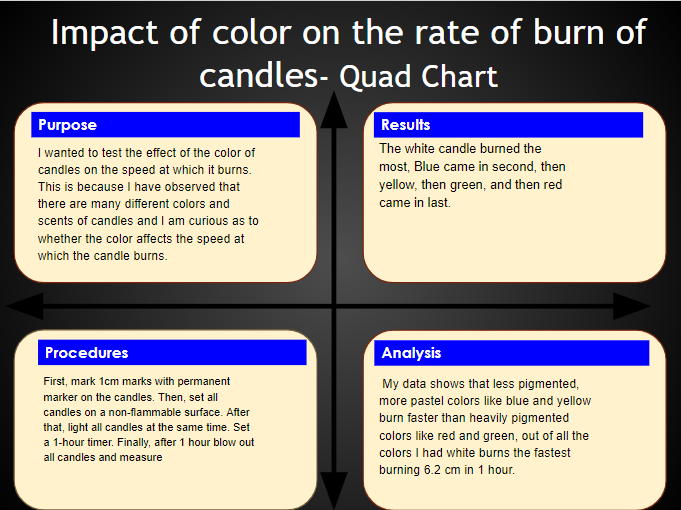Impact of Color on the Burn Rate of Candles
Abstract:
Bibliography/Citations:
Additional Project Information
Project files
Research Plan:
Hypothesis
My hypothesis is that different colored candles will have little to no impact on the speed of the candle burning. I know this is testable because it requires household and easily found materials, and I can control many variables.
Independent and Dependent Variables
Independent- Color of candles
Dependent- Distance burned
Controlled Variables
- The condition of candles- Could affect validity of results- All are from and stored in same place
- Brand of candles- Different brands manufacture candles in different ways- All are from ROOT candles, all are dipped taper candles
- Time of lighting- If not controlled can decrease the validity of the experiment- I will use all members of my family to light the candles
- Scent- May decrease the validity of the experiment (All are unscented candles)
- Height of candles- Could affect the rate at which they burn- All are 23 inch candles
Materials
- 5 Candles (Red, yellow, blue, green, white)
- 1 Lighter and/or match box
- 1 Carving tool
- 1 Measuring tool marked with cm
- 1 piece of graph paper and 1 pencil
- 1 Timing tool
- 1 Fire Extinguisher
Procedures
- Gather Materials
- Mark 1cm marks with a carving tool on the candles, with a ruler beside it to make sure that you get the right measurements, if unable to use the Permanent marker then you can use the carving tool
- Set candles on an even surface
- Make sure the candles are at least 12 in from anything flammable
- Light all candles at the same time
- Set 1-hour timer
- After 1 hour, blow out all candles and immediately measure how much they have burnt
- Use the graph paper and do the calculation of Speed = distance/time. If the distance is 6 cm then speed is 6 cm/hr
Safety
In order to maintain safe I made sure the flame was 12 inches from anything flammable, didn't leave it unattended, and had adult supervision.
Questions and Answers
1. What was the major objective of your project and what was your plan to achieve it?
The major objective of my project was to learn how to write a scientific procedure and execute an experiment. I decided to choose a simple experiment that could be easily executed and learn how to write a quality procedure.
a. Was that goal the result of any specific situation, experience, or problem you encountered?
Yes, I hadn't had any experience with writing scientific procedures and I just wanted to understand how to execute and write a scientific experiment.
b. Were you trying to solve a problem, answer a question, or test a hypothesis?
I was trying to test a hypothesis, I had originally presumed that the color of the candles would make no difference on the rate of burn and I wanted to test this hypothesis.
2. What were the major tasks you had to perform in order to complete your project?
I had to do research on the candles and I also had to work out a lot of little details as I went through the project.
a. For teams, describe what each member worked on.
3. What is new or novel about your project?
My project is novel because it inspects the correlation between color and the rate of burn. Which is not commonly inspected.
a. Is there some aspect of your project's objective, or how you achieved it that you haven't done before?
This was my first out of school science fair and my first science fair in middle school so many aspects of this were new to me including the process of writing my procedure.
b. Is your project's objective, or the way you implemented it, different from anything you have seen?
As this is a project that is not widely inspected it was not closely related with any other project base.
c. If you believe your work to be unique in some way, what research have you done to confirm that it is?
While I was looking for studies to cross confirm the results of my experiment I realized that the setup or procedure deviated from others.
4. What was the most challenging part of completing your project?
The most challenging part of my project was the writing of the procedure itself. It took me really long and was difficult for me.
a. What problems did you encounter, and how did you overcome them?
I encountered the problem of figuring out what my project was going to be, I went through several different ideas before I finally settled on one.
b. What did you learn from overcoming these problems?
I learnt that you need to be open to new ideas and not everything needs to be perfect on the first time.
5. If you were going to do this project again, are there any things you would you do differently the next time?
I think my method was very conclusive and gave me valid results. Some improvements I would make would be to bring in some more color to try to understand if the same rules apply. My data suggests that less pigmented colors, like blue and yellow burn faster than colors like green and red with white burning the fastest of them all.I would definitely like to find out more about this topic and see if there were other studies done on this topic.
6. Did working on this project give you any ideas for other projects?
This investigation made me think of a new question, the question is: do colors impact memory?
7. How did COVID-19 affect the completion of your project?
Due to the fact that this project was done at home Covid-19 did not widely affect me and my project

